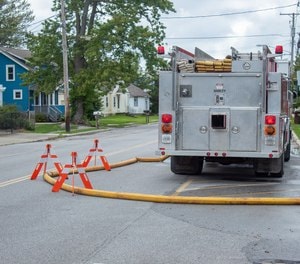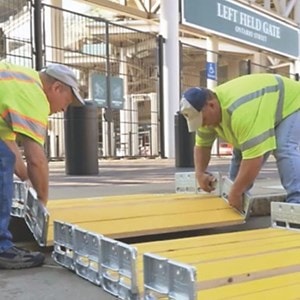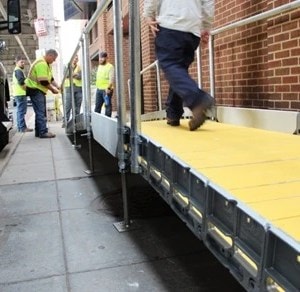CFR Title 23, Section 120
CFR Title 23, Section 120 of the Bipartisan Infrastructure Law (BIL) explains the continuation the Metropolitan Planning Program, which establishes a cooperative, continuous, and comprehensive framework for making transportation investment decisions in metropolitan areas.
§120. Federal share payable
- Interstate System Projects.-
- In general.-Except as otherwise provided in this chapter, the Federal share payable on account of any project on the Interstate System (including a project to add high occupancy vehicle lanes and a project to add auxiliary lanes but excluding a project to add any other lanes) shall be 90 percent of the total cost thereof, plus a percentage of the remaining 10 percent of such cost in any State containing unappropriated and unreserved public lands and nontaxable Indian lands, individual and tribal, exceeding 5 percent of the total area of all lands therein, equal to the percentage that the area of such lands in such State is of its total area; except that such Federal share payable on any project in any State shall not exceed 95 percent of the total cost of such project.
- State-determined lower federal share.-In the case of any project subject to paragraph (1), a State may determine a lower Federal share than the Federal share determined under such paragraph.
- Other Projects.-Except as otherwise provided in this title, the Federal share payable on account of any project or activity carried out under this title (other than a project subject to subsection (a)) shall be-
- 80 percent of the cost thereof, except that in the case of any State containing nontaxable Indian lands, individual and tribal, and public domain lands (both reserved and unreserved) exclusive of national forests and national parks and monuments, exceeding 5 percent of the total area of all lands therein, the Federal share, for purposes of this chapter, shall be increased by a percentage of the remaining cost equal to the percentage that the area of all such lands in such State, is of its total area; or
- 80 percent of the cost thereof, except that in the case of any State containing nontaxable Indian lands, individual and tribal, public domain lands (both reserved and unreserved), national forests, and national parks and monuments, the Federal share, for purposes of this chapter, shall be increased by a percentage of the remaining cost equal to the percentage that the area of all such lands in such State is of its total area; except that the Federal share payable on any project in a State shall not exceed 95 percent of the total cost of any such project. In any case where a State elects to have the Federal share provided in paragraph (2) of this subsection, the State must enter into an agreement with the Secretary covering a period of not less than 1 year, requiring such State to use solely for purposes eligible for assistance under this
title (other than paying its share of projects approved under this title) during the period covered by such agreement the difference between the State's share as provided in paragraph (2) and what its share would be if it elected to pay the share provided in paragraph (1) for all projects subject to such agreement. In the case of any project subject to this subsection, a State may determine a lower Federal share than the Federal share determined under the preceding sentences of this subsection.
- Increased Federal Share.-
- Certain safety projects.-The Federal share payable on account of any project for traffic control signalization, maintaining minimum levels of retroreflectivity of highway signs or pavement markings, traffic circles (also known as "roundabouts"), safety rest areas, pavement marking, shoulder and centerline rumble strips and stripes, commuter carpooling and vanpooling, rail-highway crossing closure, or installation of traffic signs, traffic lights, guardrails, impact attenuators, concrete barrier end treatments, breakaway utility poles, vehicle-to-infrastructure communication equipment, or priority control systems for emergency vehicles or transit vehicles at signalized intersections may amount to 100 percent of the cost of construction of such projects; except that not more than 10 percent of all sums apportioned for all the Federal-aid programs for any fiscal year in accordance with section 104 of this title shall be used under this subsection. In this subsection, the term "safety rest area" means an area where motor vehicle operators can park their vehicles and rest, where food, fuel, and lodging services are not available, and that is located on a segment of highway with respect to which the Secretary determines there is a shortage of public and private areas at which motor vehicle operators can park their vehicles and rest.
- CMAQ projects.-The Federal share payable on account of a project or program carried out under section 149 with funds obligated in fiscal year 2008 or 2009, or both, shall be not less than 80 percent and, at the discretion of the State, may be up to 100 percent of the cost thereof.
- Innovative project delivery.-
- In general. -Except as provided in subparagraph (C), the Federal share payable on account of a project, program, or activity carried out with funds apportioned under paragraph (1), (2), (5), (D), or (6) of section 104(b) may, at the discretion of the State, be up to 100 percent for any such project, program, or activity that the Secretary determines&mdash
- contains innovative project delivery methods that irf\prove work zone safety for motorists or workers and the quality of the facility;
- contains innovative technologies, engineering or design approaches, manufacturing processes, financing, or contracting or project delivery methods that improve the quality of, extend the service life of, or decrease the long-term costs of maintaining highways and bridges;
- accelerates project delivery while complying with other applicable Federal laws (including regulations) and not causing any significant adverse environmental impact or
- reduces congestion related to highway construction.
- Examples.-Projects, programs, and activities described in subparagraph (A) may include the use of-
- prefabricated bridge elements and systems and other technologies to
reduce bridge construction time; - innovative construction equipment, materials, or techniques, including the use of in-place recycling technology and digital 3-dimensional modeling technologies;
- innovative contracting methods, including the design-build and the construction manager-general contractor contracting methods and alternative bidding;
- intelligent compaction equipment;
- innovative pavement materials that have a demonstrated life cycle of 75 or more years, are manufactured with reduced greenhouse gas emissions, and reduce construction-related congestion by rapidly curing;
- contractual provisions that provide safety contingency funds to incorporate safety enhancements to work zones prior to or during roadway construction activities; or
- contractual provisions that offer a contractor an incentive payment for early completion of the project, program, or activity, subject to the condition that the incentives are accounted for in the financial plan of the project, when applicable.
- prefabricated bridge elements and systems and other technologies to
- Limitations.-
- In general. -In each fiscal year, a State may use the authority under subparagraph (A) for up to 10 percent of the combined apportionments of the State under paragraphs (I), (2), (5)(D), and {6) of section 104(b).
- Federal share increase. -The Federal share payable on account of a project, program, or activity described in subparagraph (A) may be increased by up to 5 percent of the total project cost.
- In general. -Except as provided in subparagraph (C), the Federal share payable on account of a project, program, or activity carried out with funds apportioned under paragraph (1), (2), (5), (D), or (6) of section 104(b) may, at the discretion of the State, be up to 100 percent for any such project, program, or activity that the Secretary determines&mdash
Related Articles
-
 The Traffic Safety Cone Has Been In Use For Decades – Here's How It Got Reinvented
The Traffic Safety Cone Has Been In Use For Decades – Here's How It Got Reinvented -
 4 Ways a Portable Pedestrian Ramp Makes the Community more Accessible
4 Ways a Portable Pedestrian Ramp Makes the Community more AccessibleEveryone wants a more accessible community. But the reality is that all communities have unique obstacles that create barriers for those who do not have the same mobility abilities as others. For exam...
-
 INNOVATIVE RAMP PROVIDES ACCESSIBILITY TO SIDEWALK OBSTRUCTION IN D.C. WORK ZONE
INNOVATIVE RAMP PROVIDES ACCESSIBILITY TO SIDEWALK OBSTRUCTION IN D.C. WORK ZONEA residential building in an area with heavy foot traffic needed maintenance, but the tools and machinery needed for the project created a tripping hazard. Closing the sidewalk was not an option so PS...